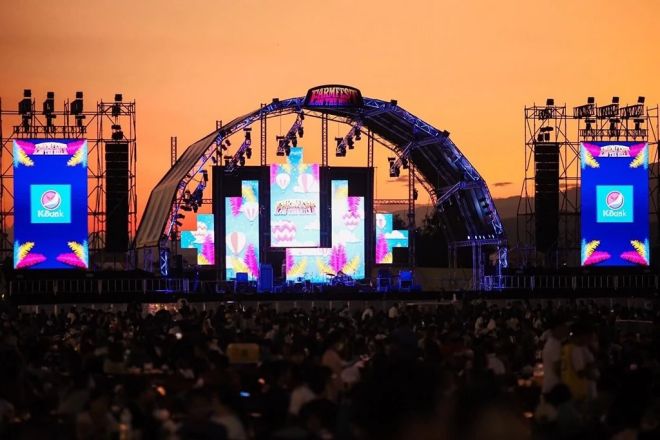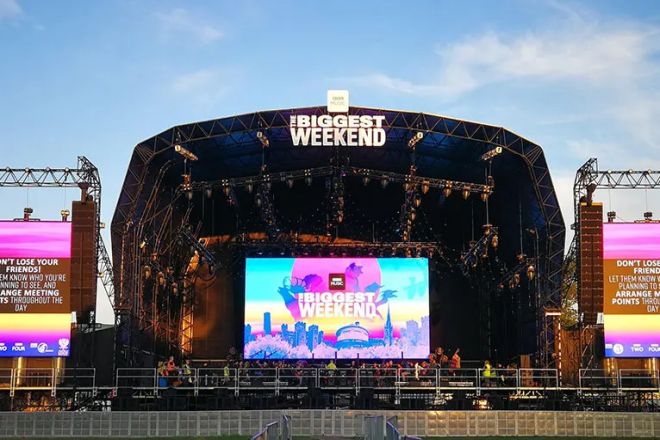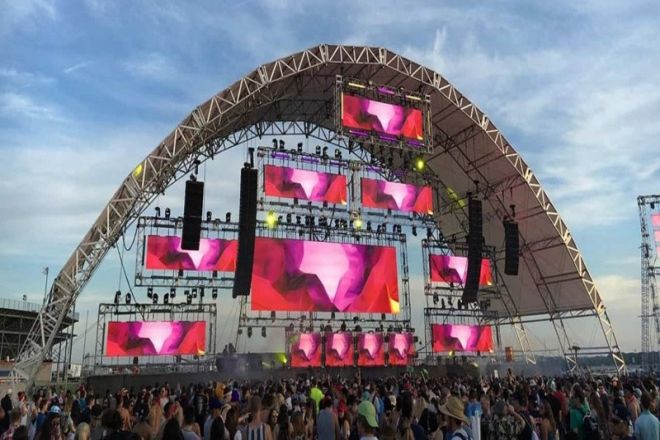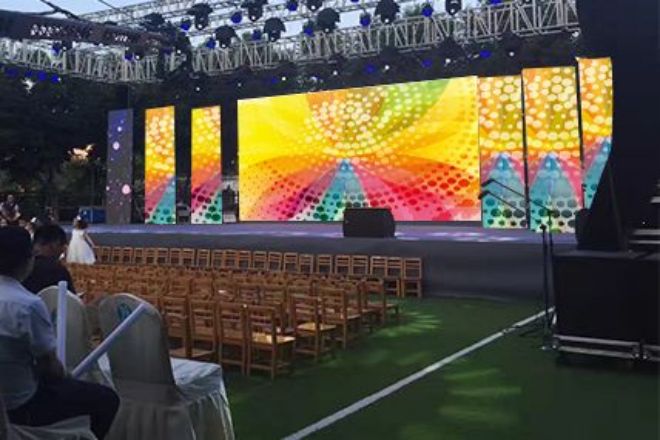序章

LEDレンタルスクリーン LEDレンタルスクリーンは、高解像度、鮮やかな色彩、そして優れた接合性により、様々なパフォーマンス、展示会、会議などのイベントで広く利用されています。しかし、使用中に様々な問題が発生することもあります。この記事では、LEDレンタルスクリーンによくある問題に対する解決策を提案し、イベントの円滑な進行をサポートします。
1. 表示の問題

1). 発生する可能性のある問題
1.1) LEDレンタルスクリーンの明るさムラ
現象の説明: LEDレンタルスクリーンを表示すると、一部のエリアの明るさが他のエリアよりも著しく高かったり低かったりするため、LEDレンタルスクリーン全体の明るさにムラが生じ、視聴体験に影響を与えます。
原因分析: この状況は、LED ランプ ビーズの老朽化、損傷、または不均一な配置、あるいは不適切な明るさ調整設定によって発生する可能性があります。
1.2) 色の歪みまたは色かぶり
現象の説明: LEDレンタルスクリーンを表示すると、表示される色が実際の色と異なり、赤みがかったり、緑がかったりして、画像の色が不正確になります。
原因分析: 色の歪みや色かぶりは、不正確な色調整、信号ソースの色設定の誤り、または LED ランプ ビーズの老朽化によって発生することがあります。
1.3) 画面がちらついたり揺れたりする
現象の説明: LEDレンタルスクリーンが表示されると、画面がちらついたり揺れたりするのが速く、人々に不安定な印象を与え、視聴効果に影響を与えます。
原因分析: 画面のちらつきやジッターは、信号源の不安定さ、伝送ラインの干渉、または LED レンタル スクリーンのリフレッシュ レート設定の不適切さによって発生する可能性があります。
1.4) 黒幕か花幕か
現象の説明: LEDレンタルスクリーンを表示すると、一部またはすべての領域に黒い画面または花の画面が表示され、コンテンツを正常に表示できず、視聴体験に重大な影響を及ぼします。
原因分析: 黒い画面や花のような画面は、LED レンタル スクリーンの接続ラインの緩み、インターフェイスの損傷、信号源の障害、または LED レンタル スクリーンのハードウェアの問題によって発生する可能性があります。
2)LEDレンタルスクリーンの表示問題の解決策
2.1) LEDレンタルスクリーンの明るさムラの解決策
LEDレンタルスクリーンの明るさ設定を調整します。 実際の状況に応じて、LEDレンタルスクリーンの全体の明るさまたは局所的な明るさの設定を調整し、各エリアの明るさの均一な分布を確保します。
LED ランプビーズの状態を確認します。 LED ランプビーズの動作状態を定期的に確認し、古くなったランプビーズや損傷したランプビーズは適時に交換してください。
明るさ調整: LED レンタル スクリーンの全体的な明るさを調整して、表示時に LED レンタル スクリーンの明るさが均一に分布されるようにします。
2.2) 色の歪みや色かぶりの解決策
色調整: LED レンタル スクリーンの色の正確さを確保するために、プロ仕様の色調整ツールを使用して LED レンタル スクリーンを調整します。
信号ソースの色設定を調整します。 実際の状況に応じて、信号ソースの色設定を調整し、LED レンタル スクリーンの色のパフォーマンスに合わせます。
古くなったランプビーズを交換してください。 LED ランプビーズの状態を定期的に確認し、ランプビーズの老朽化が見つかった場合は、色の正確さを維持するために適時に交換してください。
2.3) 画面のちらつきや揺れの解決策
信号源の安定性を確認します。 信号源の問題による画面のちらつきや揺れを回避するために、信号源が安定して動作していることを確認します。
伝送ラインを確認します。 伝送ラインに干渉や損傷がないかを確認し、必要に応じて干渉防止対策を講じるか、伝送ラインを交換してください。
LED レンタル スクリーンのリフレッシュ レートを調整します。 信号源の特性に応じて、LED レンタル スクリーンのリフレッシュ レート設定を調整し、信号源と一致し、ちらつきの問題を回避します。
2.4) ブラックスクリーンやフラワースクリーンの解決策
接続ラインとインターフェースを確認します。 LED レンタル スクリーンの接続ラインとインターフェイスが緩みや損傷なくしっかりと接続されていることを確認します。
信号源を確認します: 信号源が正常に動作しているかどうかを確認し、信号源の障害によって発生する黒い画面や花のような画面の問題を解消します。
ハードウェアの修理または交換: 検査の結果、LEDレンタルスクリーンのハードウェア(コントロールボード、ドライバーボードなど)に問題があることが判明した場合は、LEDレンタルスクリーンの正常な表示機能を回復するために、適時に修理または交換する必要があります。
2. 電気的な問題
1). 発生する可能性のある問題
1.1) 不安定または不十分な電源供給
この問題は、外部電力網の変動、電源ラインが長すぎることによる電圧減衰、または電源装置(変圧器、整流器など)の老朽化や損傷によって発生する可能性があります。
電力供給が不十分だと、機器の性能低下、動作不安定、さらには損傷の原因となる可能性があります。
1.2) ラインの老朽化または短絡
ラインの老朽化により、長期使用や環境要因(高温、多湿、腐食など)により絶縁材の劣化が起こる場合があります。
回線の損傷、露出した金属の接触、電気部品の損傷などにより短絡が発生する可能性があり、機器の損傷や火災などの重大な結果につながる可能性があります。
1.3)電気部品の故障
電気部品の故障には、スイッチ、ソケット、リレー、回路ブレーカー、モーター、変圧器などの部品の損傷や故障が含まれる場合があります。
電気部品に欠陥があると、機器が正常に動作しなくなったり、安全上の事故を引き起こしたりする可能性があります。
2)電気の問題に対する解決策
安定した電源を使用し、UPS電源を装備して電力供給を確保します。
外部電力網からの電力供給の品質を確保するために、安定した電力供給業者を選択してください。
主要な機器やシステムには、電力網が中断されたときに機器の正常な動作を確保するために一時的な電力を供給する UPS (無停電電源装置) または EPS (非常電源装置) を装備します。
UPS/EPS 機器のバッテリーの状態を定期的に確認し、古くなったバッテリーは適時に交換してください。
定期的にラインを点検し、老朽化したり損傷した配線は早めに交換してください。
目視検査、電気性能テストなどを含む定期的な検査計画を作成します。
老朽化や損傷した配線が見つかった場合は、速やかに仕様に適合した配線と交換してください。
特殊な環境(高温、多湿、腐食など)で使用する電線は、対応する保護レベルの電線を選択する必要があります。
電気部品の検査と保守を行う専門の電気技師を配置します。
専門資格を持つ電気技師を雇用し、電気部品の定期的な検査とメンテナンスを実施します。
故障が見つかった電気部品については、機器の正常な動作を確保するために、適時に交換または修理してください。
電気部品の保守記録ファイルを作成して、部品の耐用年数と保守を追跡します。
3). 追加の提案
電気安全管理システムを確立する: 電気機器の操作、検査、保守のプロセスと要件を明確にして、電気安全管理の標準化と有効性を確保します。
電気安全研修の強化:従業員の安全意識と操作スキルを向上させるために、定期的に電気安全研修を実施します。
過負荷保護装置、漏電保護装置、避雷装置などの電気保護装置を設置して、電気障害による機器や人員への影響を軽減します。
緊急時対応計画の策定: 電気系統の故障や事故の可能性に対する緊急時対応計画を策定し、緊急時対応プロセスと責任者を明確にし、電気系統の故障や事故が発生した場合に迅速かつ効果的に対応できるようにします。
3. 構造的な問題

1). 発生する可能性のある問題
- 不安定なブラケットまたは固定具
不安定なブラケットや固定具により、LED レンタル スクリーンが揺れたり、傾いたり、さらには落下したりする可能性があり、機器の正常な動作や人員の安全に重大な影響を与える可能性があります。
不安定さの原因としては、ブラケットの設計が不適切、取り付けが緩い、材料の品質が悪いなどが挙げられます。
- 継ぎ目の隙間が大きすぎるか不均一である
接合部の隙間が大きすぎたり不均一だったりすると、LED レンタル スクリーンの視覚効果に影響を与え、視聴者の視聴体験が低下します。
隙間が大きすぎたり不均一だったりする理由としては、接合技術の不良、レンタル用 LED スクリーンの材質の違い、不適切な設置調整などが考えられます。
- LEDレンタルスクリーンのサイズが設置環境に合っていません。
LEDレンタルスクリーンのサイズが設置環境に合っていない場合、映像の比率が不均衡、視覚効果が劣る、設置スペースが足りないなどの問題が発生する場合があります。
不一致の原因としては、不正確な測定、設置環境の変化、LEDレンタルスクリーンのサイズの誤った選択などが考えられます。
2)構造的な問題への解決策
LED レンタル スクリーンの安定性を確保するため、適切なブラケットと固定具を使用してください。
ブラケットの設計が適切であり、材質がしっかりしていることを確認するために、認定された信頼性の高いブラケットと固定具を選択してください。
取り付けプロセス中は、ブラケットの取り付けガイドと手順に従って、ブラケットと固定具がしっかりと安定して取り付けられていることを確認してください。
ブラケットと固定具の安定性を定期的に確認し、起こりうる問題を早期に発見して修復してください。
定期的に LED レンタル スクリーンを調整して、隙間を減らし、均一性を向上させます。
接合された LED レンタル スクリーンの場合、各 LED レンタル スクリーン間の隙間が可能な限り小さく均一になるように、接合調整を定期的に行う必要があります。
接合調整プロセスでは、調整の精度と有効性を確保するために専門的なツールと技術を使用する必要があります。
LED レンタル スクリーンを定期的に清掃およびメンテナンスして、LED レンタル スクリーンの表面を清潔で滑らかに保ちます。これにより、隙間が減り、視覚効果が向上します。
レンタル前に設置環境を慎重に計測し、適切なサイズのLEDレンタルスクリーンをお選びください。
LEDレンタルスクリーンをリースまたは購入する前に、設置環境のサイズと形状を慎重に測定し、利用可能な設置スペースと制限を把握してください。
設置環境の実際の状況に応じて、LEDレンタルスクリーンの適切なサイズと比率を選択し、LEDレンタルスクリーンのサイズが設置環境と一致するようにします。
設置環境が変化したり、LEDレンタルスクリーンのサイズを誤って選択した場合は、最適な視覚効果と設置効果を確保するために、LEDレンタルスクリーンのサイズを適時に調整または交換する必要があります。
3). 追加の提案
環境適応性を考慮する: ブラケットや固定具を選択するときは、さまざまな設置環境に適応するために、耐高温性、耐湿性、耐腐食性などの環境適応性を考慮してください。
有名ブランドを選択する: 有名ブランドの製品を選択すると、品質と性能がより保証され、アフターサービスもより充実します。
インストール ガイドに従ってください。インストール プロセス中は、インストールの正確性と安全性を確保するために、ブラケットと LED レンタル スクリーンのインストール ガイドと手順に厳密に従ってください。
オペレーターのトレーニング: オペレーターに適切なトレーニングを提供して、機器の操作、メンテナンス、注意事項を理解させ、機器の操作効率と安全性を向上させます。
4. 操作上の問題
1). 発生する可能性のある問題
- 操作インターフェースが複雑で使いにくい
操作インターフェースが複雑な場合、機器やソフトウェアを使用する際にユーザーが混乱し、作業効率が低下する可能性があります。
操作インターフェースが使いにくい原因としては、デザインが煩雑すぎる、機能のレイアウトが不合理である、直感性に欠けるなどが考えられます。
- ソフトウェアの互換性の問題
ソフトウェアの互換性の問題により、ソフトウェアが正常に動作しなくなったり、他のソフトウェアやハードウェアと競合したりする可能性があります。
互換性の問題の原因としては、互換性のないソフトウェア バージョン、オペレーティング システムの違い、ドライバーの不足などが挙げられます。
- 制御システムの故障
制御システムに障害が発生すると、機器が正常に動作しなくなり、通常の生産やサービスに影響を及ぼす可能性があります。
障害の原因としては、ハードウェアの損傷、ソフトウェアのエラー、ネットワークの問題、人為的なエラーなどが考えられます。
2)運用上の問題解決策
- 操作インターフェースを簡素化し、使いやすい操作ガイドを提供する
操作インターフェースを再設計して、より簡潔で直感的なものにし、冗長な機能と手順を削減します。
ユーザーが機器やソフトウェアの使い方をすぐに理解し、習得できるように、詳細な操作ガイドとチュートリアルを提供します。
ユーザーフィードバックチャネルを設定し、ユーザーの意見や提案をタイムリーに収集し、操作インターフェースとガイドを継続的に最適化します。
安定した動作を確保するために事前にソフトウェアの互換性をテストする
ソフトウェアをリリースする前に、さまざまなオペレーティング システム、さまざまなソフトウェア バージョン、さまざまなハードウェア構成のテストを含む、十分な互換性テストを実施してください。
さまざまな環境でソフトウェアが安定して動作することを保証するため、事前に起こりうる互換性の問題を解決します。
ソフトウェアの使用中は、ユーザーからのフィードバックや問題報告に常に注意を払い、既知の互換性の問題をタイムリーに修正します。
制御システムの障害をタイムリーに解決するために、専門的な技術サポート チームを編成します。
機器やソフトウェアの使用中にユーザーが遭遇する問題を解決するために、専門的な技術サポート チームを設置します。
制御システムの障害が発生したときにユーザーが適時に支援を受けられるように、24 時間 365 日の技術サポート サービスを提供します。
テクニカル サポート チームのスキルを定期的にトレーニングして向上させ、さまざまな複雑な問題を解決できるようにします。
制御システムに障害が発生した場合に、機器またはソフトウェアの正常な動作を迅速に回復できるように、完全な障害処理および回復メカニズムを確立します。
3). 追加の提案
複数の操作方法を提供: さまざまなユーザーのニーズと習慣を満たすために、タッチ スクリーン、キーボード、マウスなど、複数の操作方法を提供できます。
ユーザー エクスペリエンスの最適化: ユーザーのニーズとフィードバックに継続的に注意を払い、製品の設計と機能を継続的に最適化し、ユーザー エクスペリエンスを向上させます。
ユーザートレーニングの強化: 複雑な機器やソフトウェアについては、ユーザーが使用方法やスキルをよりよく習得できるように、ユーザートレーニングコースを提供します。
ユーザー コミュニティを確立する: ユーザーが使用体験を交換し、共同で問題を解決できるように、ユーザー コミュニティまたはフォーラムを確立します。
5. 輸送と設置に関する問題

1). 発生する可能性のある問題
- 輸送中のレンタルLEDスクリーンの損傷
輸送中の振動、衝突、押し出しなどにより、LED レンタル スクリーンが損傷する可能性があります。
損傷は、レンタル LED スクリーンのひび割れ、内部コンポーネントの損傷、または全体構造の変形として現れる場合があります。
- 不適切な取り付けはLEDレンタルスクリーンの変形や損傷の原因となります
取り付け時に不適切な操作(不適切な工具の使用、不均一な力、誤った取り付け手順など)を行うと、LED レンタル スクリーンが変形したり破損したりする可能性があります。
壁の凹凸、耐荷重不足、不適切な設置場所の選択など、不適切な設置環境も、LEDレンタルスクリーンの設置後に問題を引き起こす可能性があります。
- 輸送と設置の問題に対する解決策
専門の運送会社を選び、効果的な保護対策を講じてください。
輸送中の安全を確保するために、豊富な経験と評判のある輸送会社を選択してください。
輸送前に、LEDレンタルスクリーンは細かく梱包および固定され、耐衝撃フォーム、木製フレームなどの専門的な梱包材と設備を使用して、輸送中の振動と衝突を軽減します。
輸送中は、LEDレンタルスクリーンをリアルタイムで監視・追跡し、輸送ルートの安全性と円滑性を確保します。
- インストール前に詳細なインストール計画を作成し、インストールプロセスが標準化されていることを確認します。
設置前に、設置環境の詳細な調査と評価を実施し、設置場所の選択が適切であること、壁が平坦であること、耐荷重が要件を満たしていることを確認します。
LEDレンタルスクリーンの特性や設置環境に合わせて、設置手順、必要となるツール、人員配置など詳細な設置計画を策定します。
インストール プロセス中は、インストール計画に厳密に従い、すべてのステップが仕様と要件を満たしていることを確認します。
設置品質と効率性を保証する専門の設置チームを装備
インストール プロセスの専門性と正確性を確保するために、豊富な経験と専門的なスキルを持つインストール チームを選択してください。
設置チームが最新の設置技術と方法を習得できるように、定期的なトレーニングと技術更新を実施します。
設置プロセス中は、各ステップが標準と要件を満たしていることを確認するために、設置品質のリアルタイムの監視と検査が行われます。
設置が完了したら、LED レンタル スクリーンは完全にテストおよびデバッグされ、正常な動作と良好な表示効果が確保されます。
2). 追加の提案
コミュニケーションとコラボレーションの強化: 輸送および設置プロセス中に、さまざまなリンク間のコミュニケーションとコラボレーションを強化して、スムーズな情報の流れと、問題のタイムリーな発見と解決を確保します。
緊急時対応計画の策定: 問題発生時に迅速かつ効果的に対応できるよう、起こりうる緊急事態に対する緊急時対応計画と対応策を策定します。
技術サポートの提供: 設置が完了したら、LED レンタル スクリーンが使用中に最良の状態を維持できるように、必要な技術サポートとメンテナンス サービスを提供します。
継続的な改善: ユーザーのフィードバックと実際の状況に応じて、輸送および設置プロセスを継続的に改善および最適化し、サービスの品質とユーザー満足度を向上させます。
結論
LEDレンタルスクリーンは使用中に様々な問題が発生する可能性がありますが、上記の解決策を講じることで、これらの問題を効果的に解決し、イベントの円滑な進行を確保できます。また、LEDレンタルスクリーンの安定性と安全性を確保するために、レンタル前にサプライヤーを十分に調査・評価し、経験豊富で専門的な技術を持つサプライヤーを選択することをお勧めします。
最後に、LEDディスプレイスクリーンについてさらに詳しく知りたい場合は、 ご連絡ください。
